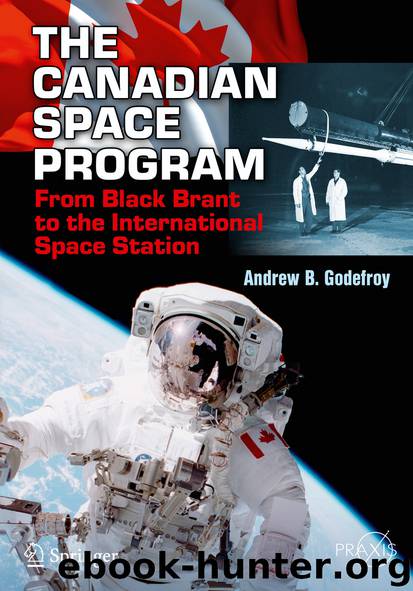The Canadian Space Program by Andrew B. Godefroy

Author:Andrew B. Godefroy
Language: eng
Format: epub
Publisher: Springer International Publishing, Cham
The level of responsibility afforded the Canadian exchange officers throughout their tours was considerable, and their success in their respective assignments was further demonstrative of the quality of RCAF officers in service at that time. Flt. Lt. Lathey made a considerable name for himself as a result of his contributions at the Air Force Flight Dynamics Laboratory (FDL) to the guidance and control and ‘fly-by-wire’ systems employed in the X-20 Dyna-Soar spacecraft. Likewise, Sqn Ldr. MacFarlane did considerable work on hypersonic ramjet research and development at Arnold Engineering Development Center, Tennessee, and Flt. Lt. T.M. Harris worked on spacecraft re-entry at the FDL.43 By the end of the 1960s, Canadians had distinguished themselves in many U.S. manned spaceflight projects, helping set the stage for later consultations that would eventually lead to Canada’s direct involvement in space shuttle operations.
The question therefore became, what opportunity and potential role was there for Canada in the American space shuttle program? The issue and desire of a manned spaceflight program was discussed, but NASA was not seeking this level of involvement from other countries at the early stages of its own program. Canadian industrial representatives traveled to Washington D.C. in October 1969 to attend a technical conference for the purpose of assessing shuttle concepts and laying out design considerations for the next steps of space shuttle development. Canadian industry was certainly interested, of course, but also somewhat concerned that unless Canada participated on a national basis there would be little hope or opportunity for individual companies to compete successfully against American organizations for contracts. It was this advice that industry leaders gave back to the ICS after the conference for further consideration.
As the ICS deliberated the potential role for Canada through 1970 and early 1971, Spar Aerospace Limited began developing its own package that envisioned a major contribution to shuttle development. It was noted during the 1969 Washington conference that early space shuttle concepts showed a spacecraft armed with a crane of sorts, but that the initial conceptual drawings forwarded by industry did not include anything resembling a remote manipulator system. It seemed instead that more effort was placed on determining the design of the airframe itself and the main engines of the shuttle than the payload bay or how exactly it was to be utilized. A subsequent proposal forwarded by North American Rockwell in 1969, for example, showed a satellite being released into orbit from a set of docking clamps in the orbiter’s payload bay. Another design advanced in 1970 by another American space company, Grumman, also showed a satellite deploying unassisted. Even more interesting is a 1971 concept artist illustration showing a NASA straight wing orbiter servicing a space station via astronaut extra-vehicular activity (EVA ) and a tethering system. While later shuttle operations did in fact employ both astronaut EVAs and a self-ejected satellite deployment mechanism, one can easily surmise how much the value of a shuttle remote manipulator system (SRMS) to assist orbital payload operations was underestimated at the time.44
It was from this initial situation that the Canadian Spar Aerospace Ltd.
Download
This site does not store any files on its server. We only index and link to content provided by other sites. Please contact the content providers to delete copyright contents if any and email us, we'll remove relevant links or contents immediately.
| Automotive | Engineering |
| Transportation |
Whiskies Galore by Ian Buxton(41523)
Introduction to Aircraft Design (Cambridge Aerospace Series) by John P. Fielding(32881)
Small Unmanned Fixed-wing Aircraft Design by Andrew J. Keane Andras Sobester James P. Scanlan & András Sóbester & James P. Scanlan(32566)
Craft Beer for the Homebrewer by Michael Agnew(17926)
Turbulence by E. J. Noyes(7689)
The Complete Stick Figure Physics Tutorials by Allen Sarah(7134)
Kaplan MCAT General Chemistry Review by Kaplan(6582)
The Thirst by Nesbo Jo(6431)
Bad Blood by John Carreyrou(6268)
Modelling of Convective Heat and Mass Transfer in Rotating Flows by Igor V. Shevchuk(6218)
Learning SQL by Alan Beaulieu(6023)
Weapons of Math Destruction by Cathy O'Neil(5818)
Man-made Catastrophes and Risk Information Concealment by Dmitry Chernov & Didier Sornette(5638)
Digital Minimalism by Cal Newport;(5379)
Life 3.0: Being Human in the Age of Artificial Intelligence by Tegmark Max(5180)
iGen by Jean M. Twenge(5149)
Secrets of Antigravity Propulsion: Tesla, UFOs, and Classified Aerospace Technology by Ph.D. Paul A. Laviolette(4972)
Design of Trajectory Optimization Approach for Space Maneuver Vehicle Skip Entry Problems by Runqi Chai & Al Savvaris & Antonios Tsourdos & Senchun Chai(4837)
Electronic Devices & Circuits by Jacob Millman & Christos C. Halkias(4739)
